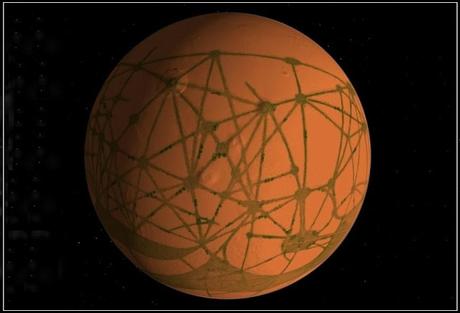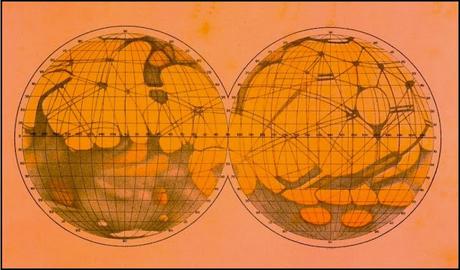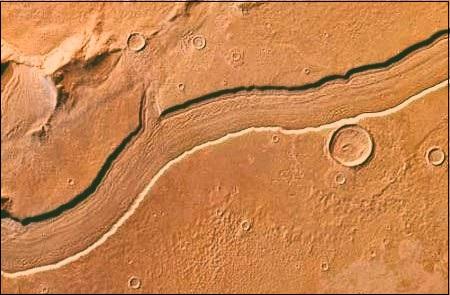Of course everybody nowadays, even flat-earthers, knows that there aren't canals on Mars. However, back in the nineteenth century, before the advent of photography, astronomers peering through their telescopes at Mars thought they identified what appeared to be a pattern of large linear features on the surface. Angelo Secchi, an Italian priest and amateur astronomer, was the first to apply the term 'canali ' (channels or gullies) in 1858,. Some twenty years later in 1877 Giovanni Shiaparelli, another Italian but an astronomer by calling, produced the first map of what he perceived these 'canali ' to be. Of course the English-speaking world decided (mistakenly) to interpret the word as canal and it became a popular misconception that there was water on Mars. In 1894 the American astronomer Percival Lowell proposed the theory that this water came from seasonal melting of the planet's polar ice-caps and that it flowed through an elaborate system of irrigation waterways that could only be the construct of some advanced civilization. He even created a super-real image of the canals of Mars (see below) which was widely published in newspapers and periodicals and the idea of intelligent, engineering Martians captured the public's imagination.

Mars as "imagined" by Percival Lowell
Following his initial pronouncement, Lowell wrote a series of books: 'Mars ' (1895), 'Mars And Its Canals ' (1905) and 'Mars As The Abode Of Life ' (1908). Schiaparelli for his part thought that Lowell's depiction of the 'canali ' of Mars was over-elaborated compared to his own original observation and charts (see below). He was also sceptical of the American's deductions and contended that the leap from what appeared to be a few channels or gullies to a full-blown hypothesis that they were man-made and carried water was just too fanciful. Good for Schiaparelli.
Mars as originally "mapped" by Schiaparelli
He was soon to be proved correct, when in 1909 more powerful telescopes were brought into play which not only saw no canals on Mars but were also able to photograph what they observed, so that the facts of the matter no longer relied upon eyewitness testimony. And by the time of WWI huge advances had been made in the science of spectroscopy which seemed to prove beyond doubt that there was no water vapour present in the atmosphere of the red planet. Canal theory debunked and case closed, you might have thought.Yes and no, for although most astronomers and scientists soon accepted that photographic evidence and spectroscopic analysis indicated neither water nor canals on Mars (Lowell and a few conspiracy theorists begged to differ), the popular imagination had been so fired up that novelists were reluctant to let such an intriguing idea go. Edgar Rice Burroughs (of 'Tarzan ' fame) led the way, featuring Martian irrigation waterways in his 1912 fiction 'A Princess Of Mars ' and its sequels. John Wyndham gave credence to those canals in 'Planet Plane ' in 1936 as did C.S. Lewis in his 1938 novel 'Out Of The Silent Planet ', and a host of less literary pulp sci-fi did the same. In fact fascination continued after WWII when Robert Heinlein's 'Red Planet ' of 1949 featured skating on frozen canals, and free-flowing canals were part of the landscape of Ray Bradbury's 'Martian Chronicles ' the following year.
It was only when the first space probes flew to Mars and sent back images and data that the concept of some sort of channels began to gain credence again in the scientific world but these were small formations, suggestive of dried up rivers (below) that had not been visible except from up close. So now the theory is that there may have been free flowing water on Mars at one time (or some other liquid element) but it has all evaporated aeons ago.

Mars as photographed by NASA
The conclusion has to be that our nearest planetary neighbor is probably as dead as it is red.... unless of course everyone is living deep underground in some fantastic hermetically sealed and self-sustaining paradise. đŸ˜‰Given the events of the last seven days in the Middle East, excuse this latest poem for not being on theme. Its title fittingly quotes from John Milton's dramatic poem 'Samson Agonistes ' and it was prompted by one of many harrowing news reports filtering out of the beleaguered Palestinian city, this about the plight of blind children.
Eyeless In GazaI beseech the sky for peace please.Even the squalid and fragile quiet that has become this shadow life since terror last visited and white phosphorus burned out my sight.As death rains down again on the
wretched enclave we call home Itremble once more, surrounded on
all sides by sounds of fear, of pain and destruction, the tortured cries
of agony and anger. We are helpless innocents in all this warring madness,
deprived of land, liberty, opportunitywhile our oppressors enjoy milk and honey. So many in our overcrowdedhell hole are just damaged children
and we suffer, the little children, howwe suffer the little children...
Thanks for reading, S ;-) Email ThisBlogThis!Share to TwitterShare to Facebook
